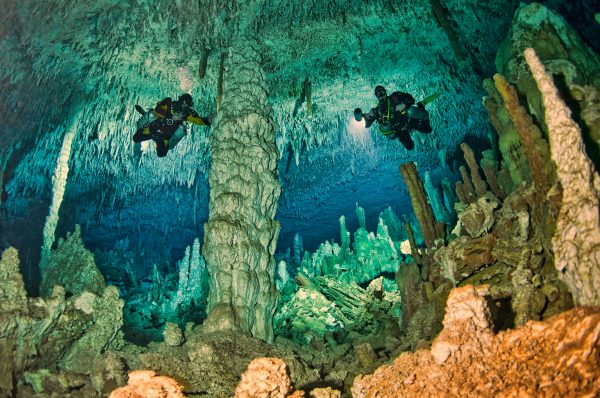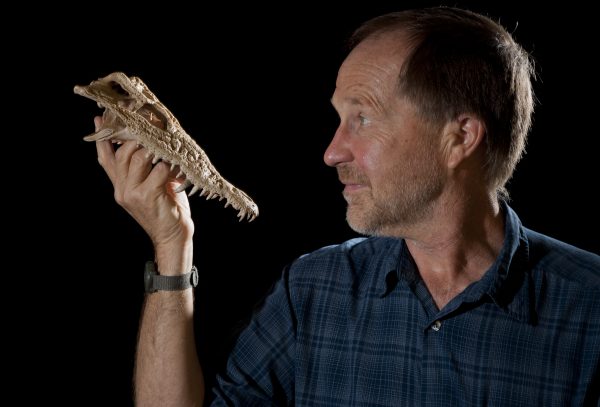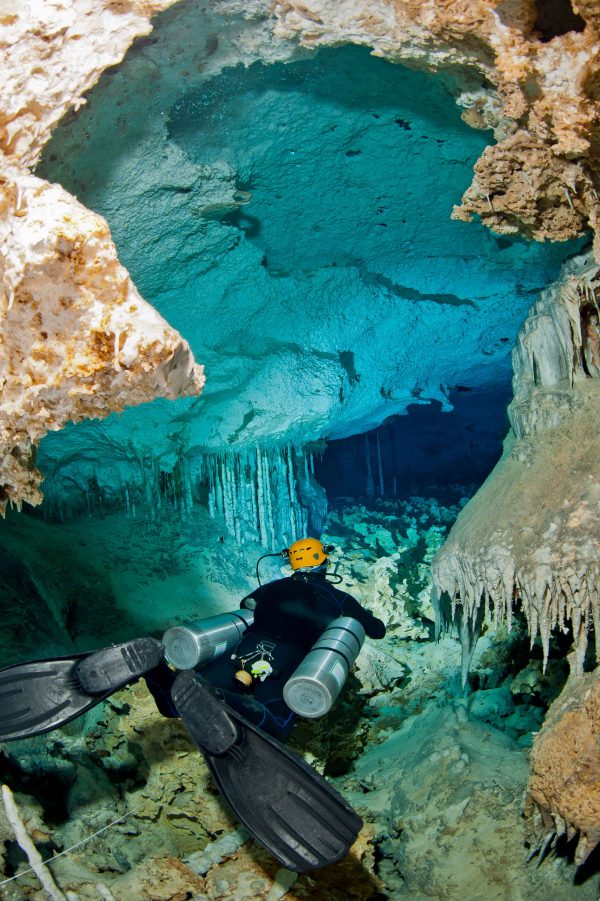
Photo courtesy of Brian Kakuk
Probing the contours of some of the world’s most dangerous underwater caves: that’s how Brian Kakuk discovered the Bahamas’ oldest crocodile, tortoise and even human remains—remnants of a sunken world.
For four years, the expert diver and scientists, including University of Florida ornithologist David Steadman, have campaigned for a plan to protect these flooded caves known as blue holes— a new national park, almost entirely underwater, which would benefit science as much as tourism and conservation. The proposal for the 34,000-acre South Abaco Blue Holes Park was recently accepted along with 14 other new marine and land parks in the Bahamas, for a total of more than 2 million acres of protected area.
It was Kakuk’s first fossil finds that started the ball rolling on discoveries that changed what scientists thought they knew about the Bahamas.
“There’s nothing like the Bahamas’ blue holes on the rest of the planet,” said Kakuk, a dive instructor and research diver based on Great Abaco Island. “There is no other place where the caves are as intricately decorated with calcium formations. From a scientific standpoint, we have basically been here since the splitting of Pangea, so the Bahamas are a great way to see how things have changed over time.”
Abaco’s earliest people frequented the much drier cave systems beginning 1,000 years ago, as many species of birds, mammals and reptiles had for thousands of years before. But as sea levels rose after the last ice age, this underground locale became submerged by water. Now, 10,000-year-old fossils pulled from Abaco’s blue holes like Sawmill Sink and Dan’s Cave—where one can find the world’s longest underwater passage—are giving scientists at the Florida Museum of Natural History on the UF campus a better understanding of the impact of human and climate-driven change on island species.

Florida Museum photo by Kristen Grace
“No other site portrays the Bahamas’ environmental heritage in more detail than Sawmill Sink,” said Steadman, curator of ornithology at the Florida Museum. “We can go back in time clear to the last ice age 15,000 years ago and examine plants and animals that are extinct on the island today.”
The cave systems that Kakuk navigates in his search for fossils create formations like “Fang Horn Forest” in Dan’s Cave where divers have just enough room to move through a passage riddled with stalactites and stalagmites that create a bed of nails on the top and bottom.
“If you’re not highly trained, it’s very dangerous. We sort of liken it to flying airplanes. You need a lot of training and lots of strict rules, because we do have accidents,” said Kakuk, a former Navy diver.
Although these fossils are protected by a labyrinth of cave passages and preserved thanks to a unique water chemistry found in the Bahamas, the blue holes and their treasures are still vulnerable. If the proposal for the new park had not been successful, there would be potential for commercial land development and pollution, Steadman said. By preventing the paving of paradise, the preservation of natural ecosystems and water flow in these areas is ensured, he said.
“If the water became more acidic, or full of organic pollutants, it would not only degrade the water quality…it would degrade the fossils,” Steadman said.
Kakuk said the pristine condition of many fossils and bones pulled from the blue holes is what draws researchers from all of the “ologies,” from archaeologists to paleontologists to geologists.
“A lot of people, when they go to look at bird or crocodile fossils, they’re usually looking at a small piece and trying to interpret what it was,” Kakuk said. “Well, we’re giving them the entire animal.”
The park will also protect a forest of endemic pine trees that grow on land above the caves and only exist on four Bahamian islands. The forest will provide space for the establishment of land-based tourism on Abaco, including trails over the tops of cave passages and bird-watching tours.
“The pine forest is an underappreciated resource in the Bahamas,” said Janet Franklin, a professor of geography at Arizona State University whose work has addressed the impacts of human-caused change on island plant communities. “In island environments that are so dominated by the ocean, people tend to forget about the land in terms of conservation. But these areas are not only important to scientific research, but essential for the survival of several endemic species in the Bahamas.”

Photo courtesy of Brian Kakuk
Steadman, Franklin and colleagues have identified from the blue hole about 50 species of birds that lived in the Bahamas during the last ice age. The Crossbill, a bird whose beak is specially adapted for taking seeds out of pine cones, is among the ice age fossils found on Abaco and reveals that pine forests have existed on the island at least 15,000 years, Franklin said.
“We’ve found that some species were able to withstand significant natural changes in climate and environment at the end of the ice age, but were still vulnerable to human activities, like forest fires,” she said.
Steadman and colleagues have recovered thousands of fossils from Sawmill Sink that show direct human activities, such as habitat destruction, pose a greater threat to island species than modern human-driven climate change. Among the 39 species that no longer exist on Abaco, 17 species of birds likely fell victim to huge changes in climate and rising sea levels around the end of the last ice age, about 10,000 years ago. Twenty-two other species of reptiles, birds and mammals persisted through those dramatic environmental changes only to vanish after humans arrived on the island 1,000 years ago.
Steadman’s future interests lie in restoring some of the animals that have been wiped out by humans. The new national parks offer scientists the opportunity to begin introducing species, including rock iguanas and tortoises, back into the Bahamas from other places where they still survive.
“We know that every island in the Bahamas used to have tortoises and that they are now extinct, but we have close relatives still living on the South American mainland,” Steadman said.
There’s growing scientific evidence that tortoises make excellent seed dispersers. They don’t digest seeds, so germination is increased after the seed passes through a tortoise’s tummy. So, the introduction of red-footed and yellow-footed tortoises could do wonders for plant life on the islands, Steadman said.
“Abaco has gone 900 years without tortoises—I’d love to see what it would look like 40 or 50 years after they are reintroduced,” Steadman said. “The new park is an area that can really inform the future and help us make it a little more natural than it is right now.”